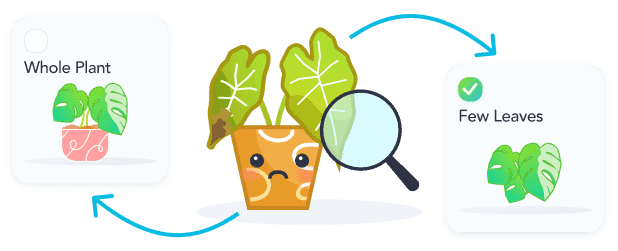Every 7d
Recommended Frequency
1 /2 cup of water
Recommended Amount
Pinstripe Calatheas like consistently moist soil, but make sure that it isn't soggy. Allow the soil to slightly dry between waterings.
Every 30d
Recommended Frequency
Fertilize your Pinstripe Calathea once a month during autumn, winter, and spring using a 15-15-15 fertilizer diluted by half.
Indirect Sun
Recommended
Indirect Sun or Filtered Sun is when sun exposure is being filtered through a sheer curtain or is not able to have the sun's rays directly hit the leaves/flowers of your plant.
Every 730d
Recommended Frequency
Repot your Pinstripe Calathea every two years, or once it outgrows its pot.
Peat Soil
Recommended Soil
Peat Soil is an acidic soil that retains a lot of moisture and slows decomposition. Due to such a high moisture retention this mix may require irrigation to help with draining. This soil type is best used when paired wit...

Shop Pinstripe Calathea
Questions about Pinstripe Calathea
The Pinstripe Calathea, scientifically known as Calathea ornata, is a tropical plant renowned for its striking foliage. It features dark green leaves adorned with thin pink or white lines that resemble pinstripes, hence ...

Toxicity of Pinstripe Calathea

Common Pests and Diseases
Root Rot
Overwatering
To address root rot in Pinstripe Calathea, first, stop watering immediately and allow the soil to dry out. Carefully remove the plant from its pot and inspect the roots. Trim away any black, mushy roots with sterilized scissors. Repot the plant in fresh, well-draining soil and a clean pot. Ensure the pot has adequate drainage holes. Resume watering with moderation, only when the top inch of soil feels dry to the touch. Consider using a moisture meter to prevent future overwatering.
Brown Leaf Edges
Underwatering
To address brown leaf edges caused by underwatering in Pinstripe Calathea, ensure a consistent watering schedule that keeps the soil evenly moist but not waterlogged. Use room temperature water to avoid shocking the plant's roots. Check the soil moisture by sticking your finger about an inch deep; if it feels dry, it's time to water. Consider using a self-watering pot to maintain consistent soil moisture levels. Additionally, increasing humidity around the plant can help prevent the edges from drying out.
Spider Mite Infestation
Spider mites are tiny pests that thrive in warm, dry conditions. They feed on the sap of the Pinstripe Calathea, causing yellowing leaves, webbing on the plant, and overall stress.
To combat spider mites, increase humidity around your Pinstripe Calathea, as these pests dislike moist conditions. Regularly misting the plant can help. Additionally, wash the leaves with a gentle stream of water to physically remove the mites and their webs. For severe infestations, use a neem oil solution or an insecticidal soap, applying it directly to the affected areas. Always isolate infested plants to prevent the spread to other houseplants.
Leaf curling
Low humidity
Pinstripe Calathea thrives in high humidity environments, often requiring levels above 60%. To address leaf curling caused by low humidity, consider placing a humidifier near the plant or creating a pebble tray filled with water to place under the plant's pot. This setup allows water to evaporate around the plant, increasing local humidity. Additionally, grouping plants together can help raise humidity levels around them through their natural transpiration process.

Related Plants
Other Articles:
Top 10 Most Popular Roses
Mar 22, 2022
How to Care for China Roses
Mar 11, 2022
How to Care for Chinese Money Plants
May 15, 2020
How to Grow and Care for A Bird of Paradise
Apr 26, 2020
Top 10 Plants To Grow In A Terrarium
May 31, 2022
How to Grow and Care for Lucky Bamboo
Mar 29, 2022
How to Grow and Care for Corn Plants
Mar 29, 2022
How to Care for Madagascar Dragon Trees
Mar 21, 2022



